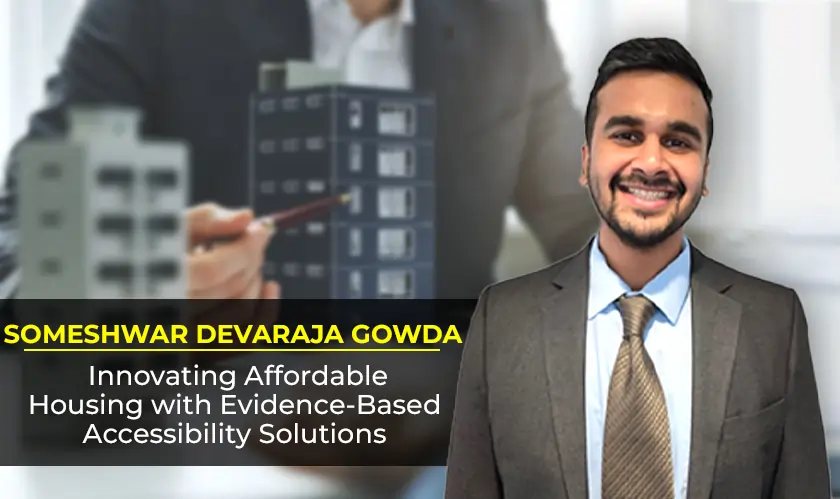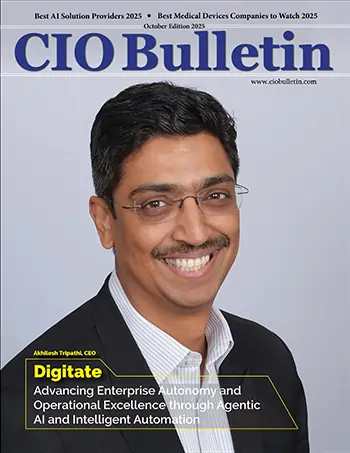Home Industry Real estate Someshwar Devaraja Gowda: Inno...
Real Estate

CIO Bulletin
13 August, 2024
The housing crisis in the United States goes beyond mere availability—it extends to accessibility.
According to the US Department of Housing and Urban Development (HUD), nearly 40% of low-income households include a person with a disability, yet most housing stock is not designed to accommodate mobility challenges, aging populations, or other accessibility needs. For many, stable housing remains out of reach because of cost and a lack of standardized methods to assess and address accessibility barriers.
But Someshwar Devaraja Gowda is determined to change that.
With a unique background that spans civil engineering, large-scale infrastructure development, hospitality investment, and affordable housing, Somu (as colleagues and friends call him) is pioneering an approach that bridges real estate investment with human-centered accessibility.
His startup is developing a standardized methodology for evaluating and rehabilitating vacant and uninhabitable housing units—ensuring they meet the needs of vulnerable populations.
Applying evidence-based person-environment (P-E) fit methodologies—particularly the Housing Enabler instrument—Someshwar continues to reshape how society understands, measures, and implements housing accessibility at scale.
As researchers Iwarsson and Ståhl explain:“The P-E fit approach provides a scientifically grounded basis for evaluating accessibility problems and guiding housing adaptations that support aging in place and independence.”
This foundational framework supports Someshwar’s vision of data-driven, human-centered housing rehabilitation.
“What we really need is a consistent, data-driven way to evaluate accessibility. Without that, we’re just patching over a much deeper issue,” he explains.
Born into a middle-class family in India, Someshwar’s early exposure to engineering came from his engineer father. His academic journey led him from the Indian Institute of Technology Madras (B.Tech, Civil Engineering) to Stanford University (MS in Civil and Environmental Engineering), where he focused on sustainable design and construction.
After graduating in 2019, he joined Traylor Bros., Inc., working on complex infrastructure projects as an engineer and estimator. He later transitioned into real estate, joining Schulte Hospitality Group in 2021, where he refined his asset management and underwriting expertise. During this period, he contributed to transactions like the $1billion+ Colony Hotel Portfolio acquisition with KKR, and developed systems that enhanced underwriting capacity and reduced reporting turnaround by 80%.
But beyond financial returns, Someshwar began seeing real estate’s shortcomings firsthand—especially in its failure to address accessibility at scale.
Schulte’s EVP Zachary Zelisko describes Someshwar’s performance at the firm as incredibly successful—with contributions including over $400M in deal volume, P&L benchmarking automation, and working with top-tier firms like PMVO, KKR, and TPG on reporting for 150+ properties.

Someshwar’s first real estate investment was more than a financial decision. At 23, he purchased his first apartment in Long Beach, CA.
“Instead of maximizing rent, I chose to lease part of it at a subsidized rate to tenants who couldn’t afford housing. That experience made me see real estate as a tool for impact, not just investment.”
“I realized that financial barriers are just one piece of the puzzle—a lot of housing simply isn’t usable for people with disabilities or older adults. That’s when it clicked—what we really need is a consistent, data-driven way to evaluate accessibility. Without that, we’re just patching over a much deeper issue.”
Once he recognized that accessibility was the missing piece, he began tackling it head-on.
“I turned to the Housing Enabler instrument, which is based on the Lawton and Nahemow model of aging. It helps assess how well a space fits the needs of people with mobility or functional limitations using a structured, data-driven approach. That’s been a game-changer for me—by applying this tool, I’ve been able to evaluate and adapt properties much faster than traditional methods.”
It’s now the foundation of our consultancy services. We help NGOs, housing authorities, and private investors assess units quickly, cut retrofitting costs by 30% to 40%, and bring vacant housing stock back into circulation for those who need it most. As Dr. Ingrid Johansson puts it, the Housing Enabler takes guessing out of accessibility planning. When used proactively, it saves time and money, and raises the overall standard for inclusive housing.”
Himani Patel, his collaborator at Purple Plate LLC, praised his leadership in repositioning a 14-unit complex in Louisville with energy-efficient upgrades while maintaining affordability standards.
Someshwar’s system combines the Housing Enabler tool with his investment acumen to transform neglected housing into inclusive, accessible units. His methodology includes:
This methodology ensures that previously uninhabitable properties aren’t just repaired—adapted to serve those who most need them.
According to Iwarsson and Ståhl, standardized, evidence-based tools like the Housing enabler are essential for creating sustainable, inclusive housing—especially for aging populations and individuals with disabilities.
Someshwar’s use of this methodology offers a scalable framework that moves beyond one-off solutions. By applying it nationally, housing authorities and developers could prioritize high-impact rehabilitations, reduce inefficiencies, and unlock underused housing stock—supporting broader goals around affordability, equity, and public health.
And Someshwar’s approach isn’t the only one in the field. Dr. Jon Pynoos, a Professor of Gerontology at the University of Southern California, noted in his paper that:“If we don’t incorporate universal design principles and assess housing suitability upfront, we’re going to pay more down the road—in healthcare costs, in emergency interventions, and in lost independence.”
Justine Murphy, Director at Magna Hospitality, remarked that Someshwar’s automation tools allowed her firm to scale portfolio analysis while adding over 60 hotels, enabling quicker decisions and improved performance.
His plan includes making 10,000 housing units accessible over a 10-year period, hiring regional managers, and publishing research to benefit the broader real estate sector.
Looking ahead, Someshwar commits himself to expanding the reach of his initiative. Over the next ten years, he aims to:
“I want to improve affordable housing supply to a point where homelessness is eliminated, and everyone can afford to rent and eventually own a home with their private resources and community support.”
Combining engineering, investment expertise, and a deep commitment to social impact, Someshwar Devaraja Gowda isn’t simply building housing—he’s building a future where accessibility and affordability are inseparable from real estate development.
About the Author
Anesia Han is a financial writer specializing in capital markets. She writes about individuals who reshape finance and make the market more accessible and profitable to investors of all backgrounds. On her days off, Anesia likes to explore restaurants and discover cuisines from all over the world.







